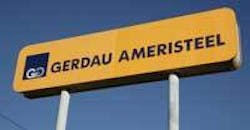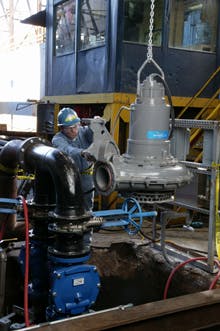Heavy Duty Submersible Pumps: Forge Solution to Scale Buildup at Steel Mini-mill
Mini-mills were a proven alternative to less profitable integrated steel mills by the time Rodney Agner started his first job as a newly minted electrical engineer in June 1989. A manufacturer of electric-arc furnaces hired and sent him to work at a mini-mill project in Charlotte, NC, the first of dozens of steel mill projects he worked at over nearly 20 years. Just over a year ago, Agner found himself back where his career started at the Charlotte mini-mill as a senior process engineer. Built in 1961, the mini-mill, now owned by Gerdau Ameristeel, melts ferrous scrap and casts the molten steel into billets. An adjacent rolling mill rolls the heated billets into various shapes.
Agner routinely resolves problems that interfere with the grueling process chain associated with modern steelmaking. Most recently, he confronted three vertical centrifugal pumps at a settling pit that no longer performed up to their mission of handling the gritty process effluent from the casting side of the facility. The two-part sump is the first stage of a closed-loop system that captures, cools and recycles process wastewater used to cool the plant’s machinery and processes.
The old pumps allowed oxidized scale off the red-hot billets to accumulate in the sump used as the first stage of the effluent reclamation. In an average year, the spray chamber and casting process can generate 1,800 tons of scale off the slurry that flows by gravity through sluiceways that feed into the sump. The effluent slurry settles out first in the lead chamber of the sump that eventually overflows into the second cell where the pumps transfer it 180' down line through an 8" line to a pond where it reaches ambient temperature and then recycles through the plant process. The old pumps proved inefficient, however, in flushing the scale from the sump. Slag would mount up in both the first and second cells of the 5' x 10' x 10' sump until maintenance crews had to use an overhead crane fitted with a clamshell and an outsourced vacuum truck contractor to purge the waste buildup. The vacuum truck contractor charged about $2,000 for each weekly cleanout.
The slurry typically carries 10,000-μm to 15,000-μm thick flakes of the oxidized metal - similar in size to corn flakes - in suspension with 160°F to 170°F process effluent. The highly abrasive scale, along with punishing heat, demanded a more efficient pump system than the three, 25-HP vertical centrifugal pumps mounted outside the pit. They no longer had the muscle to flush the gritty slurry from the sump and move it to the 30' deep cooling pond down line.
“The pumps were failing more often and it was getting hard to find parts,” Agner said. “Too much scale would settle out in the sump and conflict with the effluent flow to the cooling pond. To combat the problem, they had resorted to running all three of the former pumps to deal with the buildup, but that produced a virtually dry pit that accelerated wear on the old pumps and motors.”
In an earlier upgrade, the adjoining rolling mill had applied four ITT Flygt submersible pumps in its own closed-loop coolant system. These pumps proved reliable in handling slurry generated on that side of the operations, so Agner looked at using them to solve the problem affecting the flow of recycled water at the melting and casting side of operations. Flygt engineers called in by Brown & Morrison, its local factory representative, analyzed the problem and recommended replacing the existing vertical centrifugal pumps with abrasion-resistant Flygt Model 5550 submersible slurry pumps.
These advanced slurry pumps are specifically engineered to maintain performance in severe operating environments, such as power plants, coal mines, cement plants and, in this case, a mini-mill. Agner’s cost-benefit analysis concluded the pumps would pay for themselves within a year and help ensure operational productivity.
The 35-hp pumps were sized to deliver 1,400 gpm at 50' total dynamic head (TDH), or 22 psi. They mount on twin, stainless steel guide rails and hoist out easily for service. Features include high-discharge, wear-resistant volutes, Class S1 duty motors with Class H insulated stator windings capable of withstanding 15 starts per hour. The pumps have a double tungsten carbide seal system with an isolation zone engineered to release pressure. Embedded thermal sensors and windings protect the stator from overheating beyond the 180°F design limits. The wear-resistant component surfaces throughout are yet another feature that can withstand the gritty slurry and high temperatures inherent with the mill’s process effluent.
The pumps were aligned diagonally at 21° off center within the sump, eliminating reconstruction and piping changes. They’re lowered down the dual guide bars to automatically connect with the mounted discharge pipework. The tight, swept back design of the impeller ensures homogenous flow between vanes, minimizing wear and separation of solids and hot effluent. The pumps cycle to evenly distribute wear on each unit with only one pump normally called into play. The operating unit runs two to three times per hour, sufficient to maintain a water level between 2-½' to 6' in the pit. Both pumps activate if the water ever exceeds 8' depth, as occurred once when the discharge pipe clogged. Their operating status is remotely monitored via PLC signals in the Caster Control Room.
An added performance enhancement, the pumps incorporate an optional mechanical agitator within a heavy-duty squirrel cage. It extends off the bottom of the impeller shaft and keeps the scale more in suspension by creating a vertical thrust force that churns the effluent more effectively than traditional radial stirring of other pumps.
This now translates into more efficient transfer to the cooling pond. Coupled with a radar level control system, the pumps have delivered reliability, suppressed scale buildup and improved operating efficiency at the Charlotte mill.
“We were able to replace three of the earlier pumps with just two of the submersible units and recently eliminated hiring the vacuum truck,” Agner said. “Normally, only one pump operates to maintain the desired range of depth inside the sump... I don’t see any need to hire the truck in the foreseeable future.”
Conclusion
The mini-mill now has six Flygt pumps throughout facilities on both sides of the operations. This commonality is complemented on the mini-mill side by a proactive maintenance program in which Brown & Morrison service the units each quarter.
“With six identical pumps now in the facility, and the two pumps alternating in service on the mini-mill side, there is always immediate access to a spare pump from the mini-mill in the event of a failure,” Agner added.
ITT Flygt, a unit of ITT Corp., is based in Trumball, CT. Contact: 203-380-4700 or www.flygtus.com




